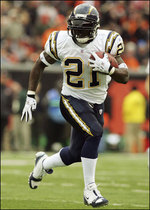Sometimes a Sponsorship is Just a Sponsorship.
In this article, CNBC writer Darren Rovell uses convoluted logic to ask what consumers, in their childlike naivete, are supposed to extract from relationships between athletes and the brands that sponsor them. (And their trainers. And their trainers' websites.)
Here's the puzzle the column poses: say you're a kid, and you want to be the next LaDainian Tomlinson. Tomlinson is part of Nike's SPARQ training program. He also wears Nikes on the field. But Todd Durkin, Tomlinson's trainer, has a website sponsored by Under Armour.
Assuming you're wack enough to think this will fundamentally alter your destiny, what do you BUY? Nike trainers or Under Armour's? The author's so stuck on this that he's even taking a poll. (Who would you follow: athlete or trainer?)
We'd laugh this whole thing off, because it really is ridiculous, but then we got to thinking. Do sponsored associations between people and products really mean something?
When Jenna Jameson posed for PETA, we understood what that meant. Jenna, like, cares about chicken. Or something.
It's probably safe to assume LaDainian Tomlinson is into Nike, because he's not just involved in Nike's training program; he also wears their shoes on the field.
But what about websites? According to the article, Tomlinson's trainer Todd Durkin went with Under Armour because they understood his vision. So Under Armour wasn't just some arbitrary website sponsorship; Durkin has positive feelings about the brand, which doesn't necessarily mean Tomlinson does.
We checked out Dooce's website today and screenshot a couple of ads. Dooce.com is all about Heather Armstrong and her family. We go there because we like reading her stories, listening to her music, checking out her ever-changing mastheads and learning about products and brands she likes and trusts.
Dooce has two Google-produced banner ads currently running on her site. One is for M13, a "functional juice" drink, and the other is for PETA.
Should we assume Heather actively endorses either brand? If she never had more than a passing thought about either one, do you imagine it would matter to her readers -- who are expected (by advertisers) to click on the ads from time to time?
From our own perspectives, as Dooce readers and inevitably also as online ad commentators, we don't expect Heather to have very strong feelings about the ads that show up on her site. We maybe expect the ads to appeal will us from time to time when we're in Dooce-reading-mode, and we expect they won't overtly offend us.
Beyond that, nada.
In the outside world, a celebrity/product relationship is powerful because advertisers assume it means something to consumers. If Alicia Keys gets behind Pro-Activ, she's lending the impression that she uses it. Stars on the red carpet don't sport dresses by labels they hate (though we might often think so).
But online, where everybody's business model is tied to advertising in some way, are we supposed to feel some connection to every brand whoring for impressions on our webpage?
Do consumers expect us to?



Comments
I am the author of the article. I'm not sure you understand what's going on here. LaDainian Tomlinson is sponsored by Nike and he is in Nike commercials. Tomlinson's trainer Todd Durkin's Web site is not only sponsored by Under Armour, but if you read the whole article, Durkin is sponsored by Under Armour and Under Armour is using Durkin to give speeches and using him to run their training program. It's actually a fascinating conversation, who is the more credible endorser in this environment? Considering that the poll now stands at 51 percent trainer, 49 percent athlete I somehow have a hard time believing the debate that I throw out there is "ridiculous," as you call it.
I asked my kid brother what he thinks and he said he's voting for Huckabee.
Sorry to offend you Darren, but a kid's gonna pick what he picks. Your hypothetical research-savvy 14-year-old will probably look into what brand suits HIM best. I doubt any hardcore Tomlinson fan is going to have an aneurism because two different individuals happen to be out there preaching the gospel of two different brands.
Kids experiment with new brands all the time. The average teen boy has got five pairs of shoes. Best-case scenario, a kid will buy both. Worst-case, neither.